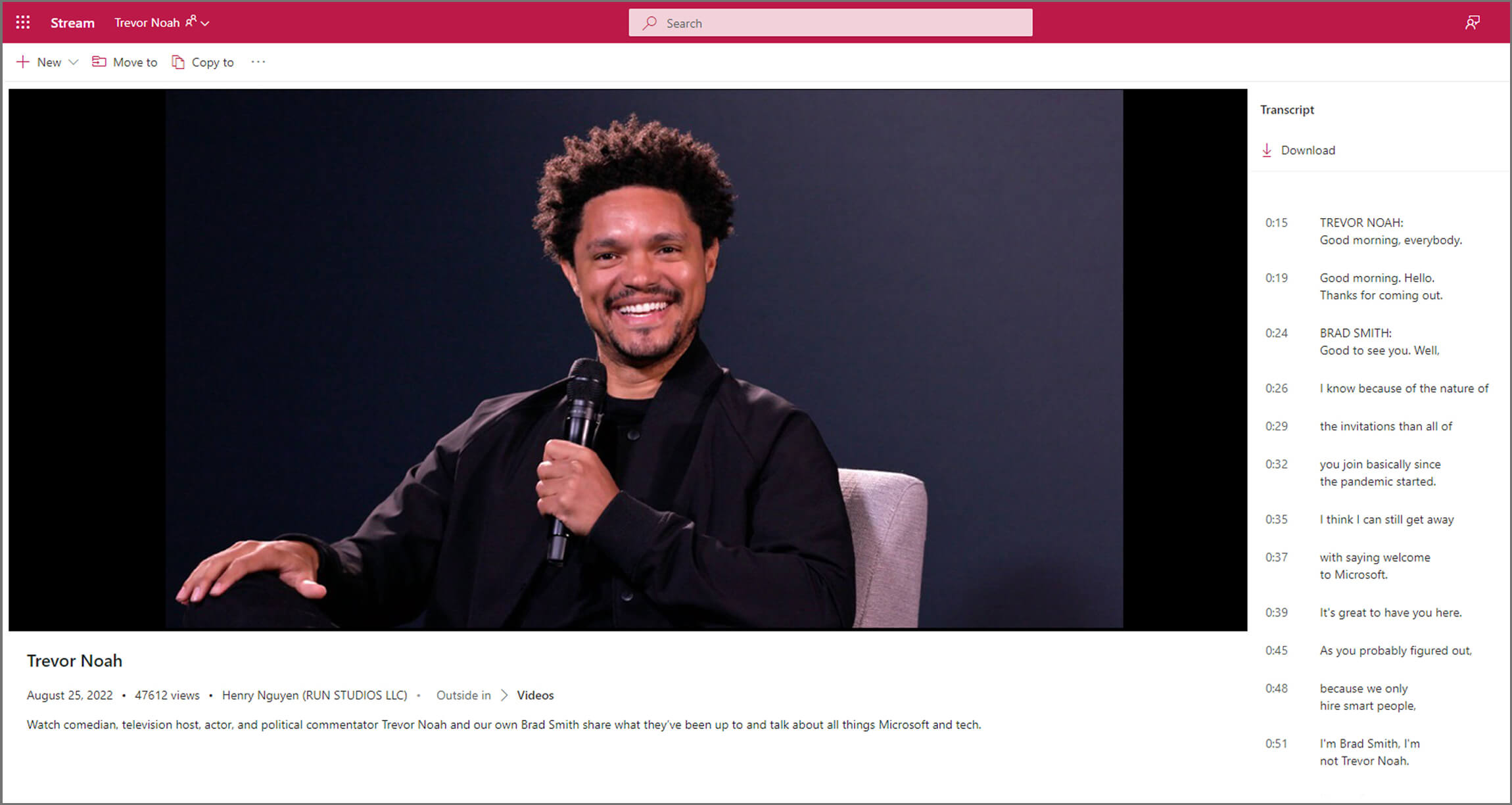 [Editor’s note: This content was written to highlight a particular event or moment in time. Although that moment has passed, we’re republishing it here so you can see what our thinking and experience was like at the time.]
[Editor’s note: This content was written to highlight a particular event or moment in time. Although that moment has passed, we’re republishing it here so you can see what our thinking and experience was like at the time.]
There’s a new way to include video in your projects thanks to the modern Microsoft Stream experience. Now native to Microsoft 365, Microsoft Stream, Microsoft’s internal video platform, empowers users to easily create, edit, upload, and publish videos to be shared inside an enterprise.
“The last few years have really shown the importance of video for hybrid work,” says Farnaz Hafezi, a program manager with Microsoft Digital Employee Experience, the organization that powers, protects, and transforms the company. “It helps us collaborate, communicate, and educate. We’ve seen a significant increase in video within our tenant.”
From recordings of Microsoft Teams meetings to short explainer videos to polished studio productions, video plays a big role at Microsoft. The revamped video platform, which is more customizable, secure, and offers better analytics and features, allows teams across Microsoft to easily release impactful content.
Now, thanks to the modern Microsoft Stream experience, early adopters at Microsoft are seeing the benefits of the upgraded product.
[Find out how Microsoft is redefining the intranet experience with SharePoint. Discover how Microsoft moved its large meetings online with live events in Microsoft 365. Read chasing the sun with live event capabilities in Microsoft 365.]
A modern spin on a familiar classic
For most of its history, Microsoft Stream was a separate solution integrated into Microsoft 365 instead of using native SharePoint and OneDrive storage like all other files.
Several factors led us to this vision—most of what people wanted added to Stream is already available through SharePoint. Customers are used to eDiscovery, retention, permission models, Microsoft Search, APIs, and analytics for files in SharePoint. They wanted video experiences that had those capabilities too, just like the other files in Microsoft 365.
—Marc Mroz, product manager, Office Media group
And while the product and its features had a large following, it didn’t perfectly align with user and IT admin expectations.
This created an opportunity to create a new experience.
“Several factors led us to this vision—most of what people wanted added to Stream is already available through SharePoint,” says Marc Mroz, a product manager for Microsoft’s Office Media group. “Customers are used to eDiscovery, retention, permission models, Microsoft Search, APIs, and analytics for files in SharePoint. They wanted video experiences that had those capabilities too, just like the other files in Microsoft 365.”
While it was possible to replicate the governance, administrative, and other capabilities of SharePoint, it would require a big effort to reach and maintain parity, matching all the functions commonly found within a product like Microsoft 365. Left in a separate solution outside of SharePoint storage, the classic experience would constantly be playing catchup to align with Microsoft 365’s features.
In pivoting to SharePoint storage, customers would get the benefits of the platform and developers would be able to offer popular features without the same degree of custom work that replication in the classic experience would require.
Bringing the modern Microsoft Stream experience to users
Microsoft Digital Employee Experience and the Office Media group engaged with teams throughout Microsoft to both promote adoption and gather feedback.
“New features for end users were coming out quickly,” Hafezi says. “We needed to make sure site admins were aware of the new experience.”
There are things we can do in modern Stream that were difficult to do in classic. Our team is a mix of employees and vendors at any given time, but the whole team needs to be able to do authoring and manage videos. Anything you can do in SharePoint, including guest permissions, is now available to us.
—David Potts, site administrator, MSW
As part of this effort, the two teams helped organizations around Microsoft employ the new platform. Organizations received hands on assistance in moving videos over to the new experience, including setting up portals so that enterprise videos could take advantage of the new product.
Immediately upon adoption, content administrators and video coordinators unlocked the benefits of Microsoft Stream being in SharePoint.
“There are things we can do in modern Stream that were difficult to do in classic,” says David Potts, a site administrator for MSW, an internal-facing intranet where employees and partners at Microsoft can discover important company news and events. “Our team is a mix of employees and vendors at any given time, but the whole team needs to be able to do authoring and manage videos. Anything you can do in SharePoint, including guest permissions, is now available to us.”
The Microsoft 365 features these users longed for, like analytics, searchability, governance, and better security, were now available. Everything was in one place, which makes it easier for editing and posting enterprise videos. It hasn’t taken long for popular features from classic Microsoft Stream, like automatically creating transcripts, have made their way over to the modern experience, but enhanced by Microsoft 365.
But there’s another way for users to reap benefits of the move.
Discovering the modern Microsoft Stream experience for yourself
While Microsoft Digital Employee Experience and the Office Media group helped teams like MSW convert to the modern Microsoft Stream experience, other organizations took advantage of public guidance on how to use enterprise video in SharePoint, thus successfully making the move independently.

“A lot of documentation came out letting people know what was already possible in the modern experience,” Mroz says. “Many people were already familiar with what they can do in SharePoint, we just helped connect the dots and showed them how to make a video destination, how to organize by folder, keyword, or metadata.”
One of these teams includes Worldwide Customer Success Account Manager (CSAM) Enablement, part of the Customer Success Organization at Microsoft. Responsible for supporting continuing education within CSAM through the use of training presentations, live events, podcasts, and video, the modern Microsoft Stream experience was a major opportunity for a team who relies heavily on video.
“When I started, there were around 50 videos on classic,” says Miranda Grueiro, a business program manager with Worldwide CSAM Enablement. “Over the course of a year, the demand for video learning and recording rapidly expanded we’re up to 132 videos and counting. We needed to make it easier to find and update our content.”
When Grueiro heard about the modern Microsoft Stream experience on SharePoint, it was clear CSAM could simplify video workflows while also creating a curated space where PowerPoints, diagrams, and videos all lived in harmony.
Using the public-facing guide for using Microsoft Stream, Grueiro found that videos could be edited, uploaded, and tagged to different areas. Wherever the video was tagged, it would surface correctly so that people could effortlessly find it.
Enterprise videos are now a regular part of the CSAM learning environment.
“Videos used to be all on their own, we had maybe two pages of embedded video links in a pivot table,” Grueiro says. “Now we have actual videos on every turn, every corner, sometimes as many as twelve in a film strip. We made consumable pages that incorporate all modalities for our users.”
A better experience for everyone
From site administrators to casual viewers, the modern Microsoft Stream experience is already having a big impact on the way the company engages with enterprise video.

Microsoft Digital Employee Experience has been able to optimize video, this includes creating policies for how long videos are stored within the system, a major cost saver.
“In Microsoft Stream classic, we noticed a lot of stale data that wasn’t being used,” Hafezi says. “We couldn’t easily go in and tell owners that an older video would be removed. In the modern Microsoft Stream experience, we can use the same retention policies and features available in Microsoft 365 to help reduce that workload and archive old content.”
Performance improvements within the SharePoint environment mean videos load faster and play better. Users can take advantage of Microsoft Search to easily connect with videos.
“All the metadata, title, descriptions, and transcripts are discoverable in Search,” Potts says. “If I’m looking for an Annie Liebowitz’ presentation from a few months ago, I can go into Microsoft Search and it will return the video. If I know there was a presentation about a recipe book, I can search those terms and find the recording of J. Kenji Lopez-Alt.”
In addition to easier workflows and improved functionality, site administrators now have access to deeper analytics, including important trends, like which videos are being watched the most, when, for how long, and how many unique viewers.
But there’s still a lot more to come.
What’s possible with the modern Microsoft Stream experience
Now that Microsoft Stream is inside Microsoft 365 and new features are being released at a regular clip, site administrators in charge of enterprise video are finding a plethora of tools and functions to play with.
The story doesn’t end here. A new migration tool is being developed to help teams across Microsoft move videos from Microsoft Azure over to SharePoint. We’re helping to pilot and test the migration tool. We have one of the largest sized tenants in the world to migrate, so we want to be strategic.
—Farnaz Hafezi, program manager, Microsoft Digital Employee Experience
“Automation is definitely the next step for us,” Potts says. “I can get efficiencies out of PowerApps and Power Automate to update metadata, move files around, create archives outside of SharePoint, and notify a group of employees that a relevant video has been posted. I definitely couldn’t do that in classic.”
As more and more teams adopt the modern Microsoft Stream experience, Microsoft Digital Employee Experience is trailblazing a method for a large-scale migration of video content from the classic environment.
“The story doesn’t end here,” Hafezi says. “A new migration tool is being developed to help teams across Microsoft move videos from Microsoft Azure over to SharePoint. We’re helping to pilot and test the migration tool. We have one of the largest sized tenants in the world to migrate, so we want to be strategic.”
The question now is how Microsoft will grab hundreds of videos from archive and bring them over, but in the meantime, teams everywhere can take advantage of the modern Microsoft Stream experience inside Microsoft 365.
“We just wanted to inspire organizations to create these video destinations,” Mroz says. “It’ll look better and be more purpose fit than classic could ever do. Now we have an out-of-the-box video platform built into SharePoint, and when we show it to customers, they get it.”

- When moving from classic to the modern Microsoft Stream experience, take stock of your current inventory, especially if you have a large archive of Microsoft Teams recordings. Not every video is going to be worth the effort of bringing along.
- Thanks to the way SharePoint sites populate content, you can elegantly use parent and child sites to share content to targeted audiences without having to duplicate efforts
- Keep your SharePoint organized; this was true before Microsoft Stream came to Windows 365 and it’s still true after
- Video is a great way to onboard new employees or offer just-in-time training. Microsoft Stream’s compatibility with Microsoft Search makes it easy for connections to be made

- Find out how Microsoft is redefining the intranet experience with SharePoint.
- Discover how Microsoft moved its large meetings online with live events in Microsoft 365.
- Read chasing the sun with live event capabilities in Microsoft 365.

Want more information? Email us and include a link to this story and we’ll get back to you.




